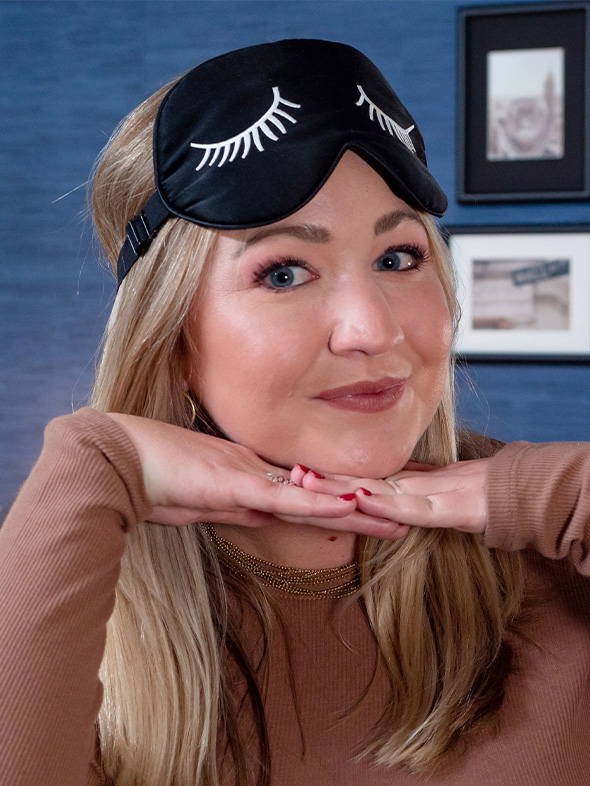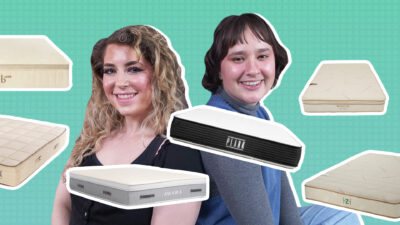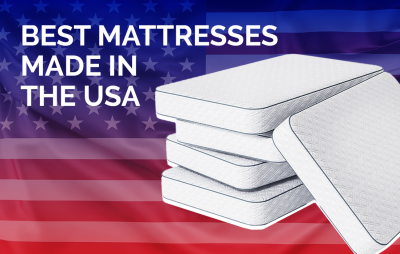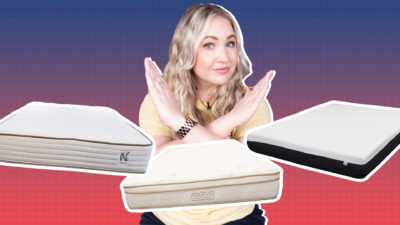Finding the best hypoallergenic mattress is important if you’re trying to keep your nighttime allergies, asthma, or any irritations at bay. These beds are equipped with materials to fight against dust, dust mites, mold, dander, and allergens — you know, all the stuff you don’t want to be sleeping on or have growing near your skin. Because there are a lot of different types of hypoallergenic mattresses on the market today, we rounded up our picks for the best hypoallergenic mattresses of the year to help you on your bed shopping journey.
Of course, if you’re spending your well-earned money on a new mattress, you’re not just looking for a bed that’s going to help keep your allergies in check. You’re most likely also looking for the right mattress for your body type, preferred sleeping position, and cooling needs. That’s why our Sleepopolis mattress testers put all of our beds through a series of tests to determine exactly what kinds of sleepers they will (or won’t) work best for. These tests include — but definitely aren’t limited to — a pressure map test to determine pressure relief, a motion transfer test to see if couples will be able to feel the movements of their partner, and scoring each mattress’s firmness (with 1 being the softest and 10 being the firmest).
All of our recommendations for these mattresses will be outlined in the Pros and Cons section of each bed’s mini review, so make sure you check that section out before clicking “purchase” on your new bed. Keep on reading this roundup to find the hypoallergenic mattress that’s best for you.
Our Top Pick for Hypoallergenic Mattresses
We chose the Puffy Cloud as our top pick for hypoallergenic mattresses because of its luxurious materials and soft foam that provides soothing pressure relief.
Best Hypoallergenic Mattresses 2024
- Best Overall Hypoallergenic Mattress – Puffy Cloud
- Best Hypoallergenic Mattress for Combination Sleepers – DreamCloud
- Best Hybrid Hypoallergenic Mattress – Saatva Latex Hybrid
- Best Hypoallergenic Mattress for Back Pain – WinkBeds EcoCloud
- Best Hypoallergenic Mattress for Couples – Nectar Premier
- Best Firm Hypoallergenic Mattress – Helix Dawn
- Best Cooling Hypoallergenic Mattress – Bear Star Hybrid
- Best Hypoallergenic Mattress for Side Sleepers – Nolah Natural
- Best Organic Hypoallergenic Mattress – Birch
- Best Flippable Hypoallergenic Mattress – Layla
Best Hypoallergenic Mattresses Video

Compare Hypoallergenic Mattresses
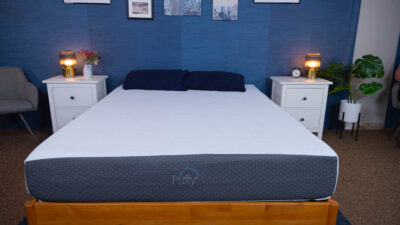
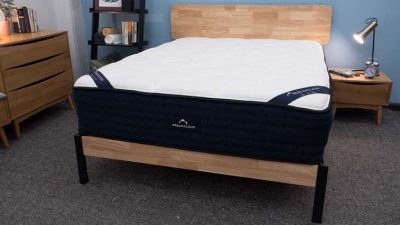
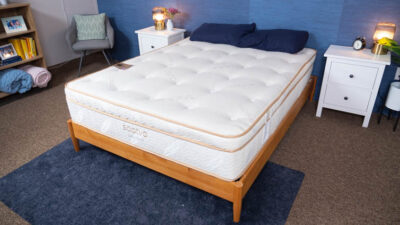
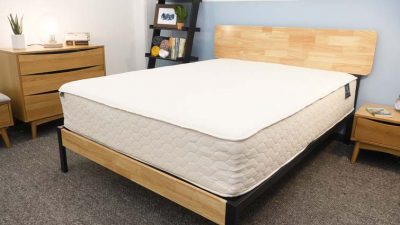

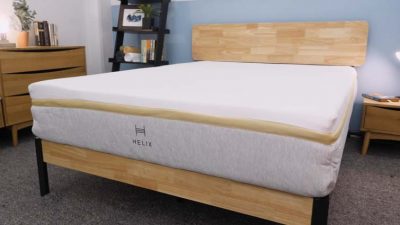
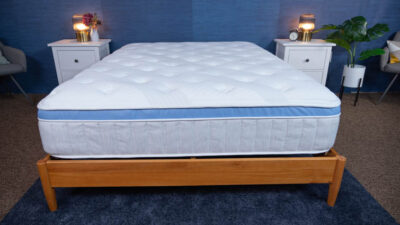
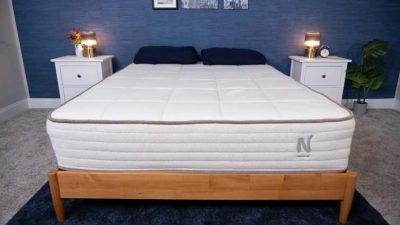
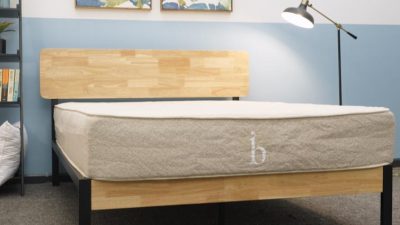
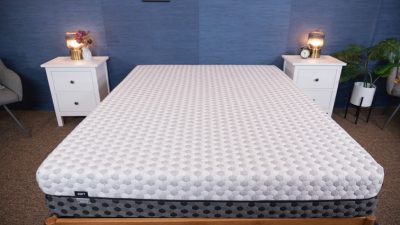
Puffy Cloud Mattress
DreamCloud Original Mattress
Saatva Latex Hybrid Mattress
WinkBeds EcoCloud Mattress
Nectar Premier Mattress
Helix Dawn Mattress
Bear Star Hybrid Mattress
Nolah Natural Mattress
Birch Natural Mattress
Layla Mattress
Rating
Firmness
Medium-soft: 6/10
Firm: 7/10
Firm: 7.5/10
Medium-firm: 6.5/10
Medium-soft: 6/10
Firm: 7.5/10
Soft: 6/10
Medium-soft: 6/10
Medium-firm: 7/10
Multiple firmness options
Material
Foam
Hybrid
Latex
Latex
Foam
Hybrid
Hybrid
Latex
Hybrid
Foam
Cooling
--
✓
✓
--
--
--
✓
✓
✓
✓
Sleep Position
Back & Side
Back
Back & Stomach
Back & Side
Back & Side
Back & Stomach
Back & Side
Combination
Back & Stomach
Combination
Best Overall Hypoallergenic Mattress – Puffy Cloud
The Puffy Cloud is an all-foam bed-in-a-box with a medium firmness that is great for a wide range of sleepers. It also does a good job of reducing aches and pains, thanks to its balance of support and pressure relief.
We recommend this mattress for the following sleeper types: Financing options are available for this mattress. I love this mattress. I wake up rested and with energy. Before I was sleeping on a traditional mattress and I would wake up 3 to 4 times at night trying to find the right spot. I don't weak up in middle of the night. It was worth every penny!!!
The Puffy Cloud is an all-foam bed-in-a-box with a medium firmness that is great for a wide range of sleepers. It also does a good job of reducing aches and pains, thanks to its balance of support and pressure relief.
We recommend this mattress for the following sleeper types: Financing options are available for this mattress. I love this mattress. I wake up rested and with energy. Before I was sleeping on a traditional mattress and I would wake up 3 to 4 times at night trying to find the right spot. I don't weak up in middle of the night. It was worth every penny!!!
The Puffy Cloud is an all-foam bed-in-a-box with a medium firmness that is great for a wide range of sleepers. It also does a good job of reducing aches and pains, thanks to its balance of support and pressure relief.
We recommend this mattress for the following sleeper types: Financing options are available for this mattress. I love this mattress. I wake up rested and with energy. Before I was sleeping on a traditional mattress and I would wake up 3 to 4 times at night trying to find the right spot. I don't weak up in middle of the night. It was worth every penny!!!
Puffy Cloud Mattress

Material
Foam
Trial Period
101 nights
Shipping Method
Free shipping
Firmness
Medium-soft: 6/10
Warranty
Lifetime warranty
Price Range
$$$$$
Kids
This bed is perfect for young sleepers.
Back Pain
This bed is perfect for anyone suffering from back pain.
Back Sleeping
Ideal for lightweight and average weight back sleepers.
Side Sleeping
Ideal for lightweight and average weight side sleepers.
Financing Options
Puffy Cloud Mattress

Material
Foam
Warranty
Lifetime warranty
Firmness
Medium-soft: 6/10
Shipping Method
Free shipping
Trial Period
101 nights
Price Range
$$$$$
Kids
This bed is perfect for young sleepers.
Back Pain
This bed is perfect for anyone suffering from back pain.
Back Sleeping
Ideal for lightweight and average weight back sleepers.
Side Sleeping
Ideal for lightweight and average weight side sleepers.
Financing Options

Puffy Cloud Mattress
Material
Foam
Firmness
Medium-soft: 6/10
Trial Period
101 nights
Warranty
Lifetime warranty
Shipping Method
Free shipping
Price Range
$$$$$
Kids
This bed is perfect for young sleepers.
Back Pain
This bed is perfect for anyone suffering from back pain.
Back Sleeping
Ideal for lightweight and average weight back sleepers.
Side Sleeping
Ideal for lightweight and average weight side sleepers.
Financing Options
Expert Opinion
The Puffy Cloud uses eco-friendly materials throughout its construction, starting with its top layer. This layer includes a hypoallergenic cover combined with a polyester-blend. Together, this creates a soft, cozy feel upon lying down. As an added bonus, you won’t have to worry about your allergies acting up when laying on this mattress. All of these traits are why we chose it as our best hypoallergenic mattress.
Along with being hypoallergenic, the Puffy Cloud sports cushiony support and a stain-resistant cover, which could make it a great fit for kids (especially if you don’t want to be constantly cleaning their bedding). This is important to highlight, since not all bed-in-a-box mattresses are the best fit for little ones. But younger bodies should get both the pressure relief and support they need from the Puffy Cloud as they grow, thanks to the different types of foam used in its construction, including a “Gel Cloud” comfort layer and a high-density poly foam layer.
What our tester says: “I really enjoyed the combination of pressure relief and support the Puffy offers. I think it will do a good job of reducing aches and pains that some people experience when sleeping on a mattress that isn’t the right firmness level for their sleep style.” – Bridget Chapman, senior product editor
What Customers Say
Many customers on the Puffy website praise the Puffy Cloud for its ability to alleviate back pain. These users stated that they could feel the foams in this mattress filling in the space around their lumbar region, giving them some much needed pressure relief.
Pros of the Puffy Cloud Mattress
- The balance of pressure relief and support on the Puffy Cloud makes this a good mattress choice for back sleepers. They should get strong pressure relief around their lumbar region, all while their spine stays in a neutral alignment.
- This mattress was specifically designed to alleviate pain around pressure points like the hips and shoulders, so if you suffer from pain in these areas (especially if you prefer to sleep on your back or side), this might be the mattress for you.
- The Puffy Cloud scored very well on our motion isolation test. This means that couples shouldn’t be able to feel the movements of their restless partner during the night.
Cons of the Puffy Cloud Mattress
- Heavier sleepers (those over 250 pounds) might want to steer clear of the Puffy Cloud because it is considered a softer mattress. These sleepers are most likely going to need a bed that is more stable and durable. For some other options, check out our roundup of the best mattresses for heavy people.
Want to learn more? Click here to see our best deals, or read our full Puffy Cloud mattress review. Still looking for the perfect mattress? Check out our roundup of the best overall mattresses of 2024.
Best Hypoallergenic Mattress for Combination Sleepers – DreamCloud
The DreamCloud Mattress is a luxury hybrid mattress made with layers of memory foam and pocketed coils. It offers a great combination of support and pressure relief that back sleepers will really enjoy.
We recommend this mattress for the following sleeper types: Financing options are available for this mattress. I have purchased 5 different Dreamcloud mattresses over the years and never once disappointed. Always fast shipping. Fantastic pricing. But by far the best feature is the quality of the Dreamcloud mattress. Also very impressed with the free bedding (sheets) that came with my recent two purchases. Don’t change what you are doing/offering. It’s perfect in every way.
The DreamCloud Mattress is a luxury hybrid mattress made with layers of memory foam and pocketed coils. It offers a great combination of support and pressure relief that back sleepers will really enjoy.
We recommend this mattress for the following sleeper types: Financing options are available for this mattress. I have purchased 5 different Dreamcloud mattresses over the years and never once disappointed. Always fast shipping. Fantastic pricing. But by far the best feature is the quality of the Dreamcloud mattress. Also very impressed with the free bedding (sheets) that came with my recent two purchases. Don’t change what you are doing/offering. It’s perfect in every way.
The DreamCloud Mattress is a luxury hybrid mattress made with layers of memory foam and pocketed coils. It offers a great combination of support and pressure relief that back sleepers will really enjoy.
We recommend this mattress for the following sleeper types: Financing options are available for this mattress. I have purchased 5 different Dreamcloud mattresses over the years and never once disappointed. Always fast shipping. Fantastic pricing. But by far the best feature is the quality of the Dreamcloud mattress. Also very impressed with the free bedding (sheets) that came with my recent two purchases. Don’t change what you are doing/offering. It’s perfect in every way.
DreamCloud Original Mattress

Material
Hybrid
Trial Period
365 nights
Shipping Method
Free shipping
Firmness
Firm: 7/10
Warranty
Lifetime warranty
Price Range
$$$$$
Hot Sleepers
If you often overheat while you sleep, this mattress should help you stay cool.
Seniors
This bed is perfect for senior sleepers.
Back Sleeping
Ideal for average weight back sleepers.
Financing Options
DreamCloud Original Mattress

Material
Hybrid
Warranty
Lifetime warranty
Firmness
Firm: 7/10
Shipping Method
Free shipping
Trial Period
365 nights
Price Range
$$$$$
Hot Sleepers
If you often overheat while you sleep, this mattress should help you stay cool.
Seniors
This bed is perfect for senior sleepers.
Back Sleeping
Ideal for average weight back sleepers.
Financing Options

DreamCloud Original Mattress
Material
Hybrid
Firmness
Firm: 7/10
Trial Period
365 nights
Warranty
Lifetime warranty
Shipping Method
Free shipping
Price Range
$$$$$
Hot Sleepers
If you often overheat while you sleep, this mattress should help you stay cool.
Seniors
This bed is perfect for senior sleepers.
Back Sleeping
Ideal for average weight back sleepers.
Financing Options
Expert Opinion
The DreamCloud definitely has more of an “on top” feel to it, rather than allowing its sleepers to “sink” further into its layers. This makes this mattress a great fit for combination sleepers, as they will be able to more easily switch positions and move around on top of their mattress without feeling stuck. This mattress also scored a 7 on our firmness scale, making it slightly firmer than the industry standard for a medium-firm bed.
Switching over to the hypoallergenic capabilities of this mattress, it was constructed using a cashmere blend cover, gel infused memory foam, and individually wrapped coils. All of these high-quality materials allow for sleepers with allergies to rest easy knowing they won’t have a reaction to their bed during the night (maybe one of the reasons why this mattress is DreamCloud’s most popular model).
What our tester says: “I found that the breathable cashmere cover helps the DreamCloud sleep cool throughout the night. I also appreciate how well this bed could work for couples. They won’t overheat on the DreamCloud or feel too disturbed by each other’s movements.” – Bridget Chapman, senior product editor
What Customers Say
Customers on the DreamCloud website couldn’t stop talking about how comfortable this mattress really feels — to the point where they don’t want to get out of bed in the morning. Some users even compared sleeping on this bed to sleeping on an actual cloud.
Pros of the DreamCloud Mattress
- The gentle pressure relief, supportive foam, and sturdy coils included in the DreamCloud’s construction make this mattress a good choice for back sleepers, as it should allow for their lower back to be comforted, while also keeping their spine in a neutral alignment.
- The DreamCloud mattress is designed with additional cooling materials that allow for breathability and airflow throughout its layers. This is an added bonus for hot sleepers who want some extra cooling during the night.
- The pocketed coils make this mattress especially bouncy and responsive, equating to a good bed for sex. Couples should appreciate this addition, as it will allow them to more easily switch positions on top of their bed’s layers.
Cons of the DreamCloud Mattress
- Strict side sleepers might find that the DreamCloud is a little too firm for their liking. These sleepers usually need a softer mattress that can provide added pressure relief around their hips and shoulders. We recommend that these sleepers take a look at our roundup of the best mattresses for side sleepers.
Does this bed sound like a dream? Click here to see our best deals, or read our full DreamCloud mattress review. Still looking for your dream mattress? Check out our roundup of the best mattresses for combination sleepers.
Best Hybrid Hypoallergenic Mattress – Saatva Latex Hybrid
The Saatva Latex Hybrid is a firmer hybrid model, combining latex foam and individually pocketed coils for excellent bounce and mobility. It has good pressure relief, so we recommend it for back, stomach, and combo sleepers.
We recommend this mattress for the following sleeper types: Financing options are available for this mattress. The Saatva Latex Hybrid is a firmer hybrid model, combining latex foam and individually pocketed coils for excellent bounce and mobility. It has good pressure relief, so we recommend it for back, stomach, and combo sleepers.
We recommend this mattress for the following sleeper types: Financing options are available for this mattress. The Saatva Latex Hybrid is a firmer hybrid model, combining latex foam and individually pocketed coils for excellent bounce and mobility. It has good pressure relief, so we recommend it for back, stomach, and combo sleepers.
We recommend this mattress for the following sleeper types: Financing options are available for this mattress.Saatva Latex Hybrid Mattress

Material
Latex
Trial Period
365 nights
Shipping Method
Free white glove delivery
Firmness
Firm: 7.5/10
Warranty
Lifetime warranty
Price Range
$$$$$
Hot Sleepers
If you often overheat while you sleep, this mattress should help you stay cool.
Back Pain
This bed is perfect for anyone suffering from back pain.
Back Sleeping
Ideal for average weight and heavyweight back sleepers.
Stomach Sleeping
Ideal for lightweight, average weight, and heavyweight stomach sleepers.
Financing Options
Saatva Latex Hybrid Mattress

Material
Latex
Warranty
Lifetime warranty
Firmness
Firm: 7.5/10
Shipping Method
Free white glove delivery
Trial Period
365 nights
Price Range
$$$$$
Hot Sleepers
If you often overheat while you sleep, this mattress should help you stay cool.
Back Pain
This bed is perfect for anyone suffering from back pain.
Back Sleeping
Ideal for average weight and heavyweight back sleepers.
Stomach Sleeping
Ideal for lightweight, average weight, and heavyweight stomach sleepers.
Financing Options

Saatva Latex Hybrid Mattress
Material
Latex
Firmness
Firm: 7.5/10
Trial Period
365 nights
Warranty
Lifetime warranty
Shipping Method
Free white glove delivery
Price Range
$$$$$
Hot Sleepers
If you often overheat while you sleep, this mattress should help you stay cool.
Back Pain
This bed is perfect for anyone suffering from back pain.
Back Sleeping
Ideal for average weight and heavyweight back sleepers.
Stomach Sleeping
Ideal for lightweight, average weight, and heavyweight stomach sleepers.
Financing Options
Expert Opinion
We picked the Saatva Latex Hybrid as our best hybrid hypoallergenic mattress because of its firm, bouncy feel, which should appeal to a variety of folks. This includes back sleepers, stomach sleepers, and heavy people. The mattress scored a 7.5 on our firmness scale, making it firmer than the industry standard for a medium-firm bed (which is set at a 6.5 on our scale). This rating means that the Saatva Latex Hybrid has a good balance of comfort and stability in its construction.
In terms of organic materials, the Saatva Latex Hybrid includes an organic cotton cover on top that’s also quilted with wool. The comfort layer of this bed is comprised of Talalay latex — a material that is naturally antimicrobial, as well as being able to dissipate body heat, making it a good choice for hot sleepers or couples with double the body heat in their bed. Even the base of the Saatva Latex Hybrid is organic, with an eco loft pad made of organic wool and cotton covering the individually wrapped coils.
What our tester says: “I was impressed with the support I received and the overall solid feel of the mattress. The Saatva Latex Hybrid is well built and uses durable materials to stand the test of time. ” – Logan Block, former Sleepopolis director of content and mattress tester
What Customers Say
Customers on the Saatva website had the most to say about the customer service they received from this brand. Multiple users stated that they were able to get in touch with a sales associate immediately, and they never felt like they were being pushed toward a specific (or more expensive) mattress.
Pros of the Saatva Latex Hybrid Mattress
- The Saatva Latex Hybrid has a very “on top” feel to it, which makes it a good choice for combination sleepers. These sleepers need a firm mattress so that they can move around and switch positions easily, without getting “stuck” in the layers.
- Heavier sleepers (those over 250 pounds) should appreciate how supportive and durable the Saatva Latex Hybrid is. Not only will this bed support their frame, but it should also be able to stand the test of time.
- The Saatva Latex Hybrid is what we would describe as a good mattress for sex. This is because the combination of latex and coils makes it especially bouncy and responsive, so couples can switch positions easily on top of its layers.
Cons of the Saatva Latex Hybrid Mattress
- Strict side sleepers are probably going to feel like this mattress is too firm for them. They’re most likely aren’t going to receive the pressure relief they need around sensitive joints, like the hips and shoulders. Instead, we recommend that these sleepers check out our roundup of the best mattresses for side sleepers.
Want to learn more? Click here for our best deals, or read our full Saatva Latex Hybrid mattress review. Not convinced yet? Take a look at our roundup of the best hybrid mattresses.
Best Hypoallergenic Mattress for Back Pain – WinkBeds EcoCloud
This is one of the most sustainable mattresses I’ve tested. It is also a fantastic mattress for combination sleepers, who will like its bounciness and appreciate how comfortable it feels in a range of positions. It also features zoned support, making it good for those with pain concerns.
This is one of the most sustainable mattresses I’ve tested. It is also a fantastic mattress for combination sleepers, who will like its bounciness and appreciate how comfortable it feels in a range of positions. It also features zoned support, making it good for those with pain concerns.
This is one of the most sustainable mattresses I’ve tested. It is also a fantastic mattress for combination sleepers, who will like its bounciness and appreciate how comfortable it feels in a range of positions. It also features zoned support, making it good for those with pain concerns.
WinkBeds EcoCloud Mattress

Material
Latex
Trial Period
120 nights
Shipping Method
Free shipping
Firmness
Medium-firm: 6.5/10
Warranty
Lifetime warranty
Price Range
$$$$$
WinkBeds EcoCloud Mattress

Material
Latex
Warranty
Lifetime warranty
Firmness
Medium-firm: 6.5/10
Shipping Method
Free shipping
Trial Period
120 nights
Price Range
$$$$$

WinkBeds EcoCloud Mattress
Material
Latex
Firmness
Medium-firm: 6.5/10
Trial Period
120 nights
Warranty
Lifetime warranty
Shipping Method
Free shipping
Price Range
$$$$$
Expert Opinion
You can rest assured knowing you’re sleeping on eco-friendly materials with the WinkBeds EcoCloud. This mattress includes an organic cover made from cotton and sustainable New Zealand wool. There’s also a 4-inch layer comfort layer of Talalay latex included in the EcoCloud, which is antibacterial, hypoallergenic, and non-toxic. This mattress also scored a 6.5 on our firmness scale, which is the same score as the industry standard for a medium-firm mattress.
This score helps out when it comes to back sleeping because it offers a good balance between stability and comfort. The EcoCloud includes zoned support in its construction, which basically means that some areas of the mattress are more supportive while others are more contouring. This helps sleepers who suffer with back pain because the added pressure relief in the lower back gives their lumbar region some cushioning, while the support in the middle of the mattress helps keep their spine neutrally aligned.
What our tester says: “I love how environmentally friendly this mattress is. Its natural latex, organic cotton and wool, and recycled steel coils make it one of the most sustainable mattresses I’ve tested.” – Zoë Ettinger, former Sleepopolis editor and mattress tester
What Customers Say
Many of the comments on the WinkBeds website talked about how well this mattress alleviated their hip pain. Even side sleepers said that, despite laying on their hips and shoulders every night, they could tell a difference in the amount of pain they experienced in the morning after sleeping on the EcoCloud.
Pros of the EcoCloud Mattress
- The materials included in this mattress make it very responsive, which is especially important for combination sleepers, who are looking for a bed they can easily switch positions in without getting stuck.
- The organic materials in this mattress (like the cotton cover, latex layer, and individual coils) help to keep the EcoCloud breathable and cooling for hot sleepers and couples with double the body heat in their bed.
- The EcoCloud scored well on our pressure map test when it came to shoulder and hip pain for back or stomach sleeping. However, side sleepers who suffer with shoulder or back pain are probably still going to want a softer mattress than the EcoCloud.
Cons of the EcoCloud Mattress
- The EcoCloud is not the best mattress for isolating motion, so lightweight couples may be disturbed by their partner’s movements during the night. If this sounds like you, check out our roundup of the best mattresses for couples for some better motion isolation options.
Want more information? Click here to see our best deals, or check out our full WinkBeds EcoCloud mattress review. If you want more options, take a look at our roundup of the best mattresses for back pain.
Best Hypoallergenic Mattress for Couples – Nectar Premier
The Nectar Premier mattress is a medium-soft memory foam mattress, making it a great fit for side sleepers or those who deal with shoulder or hip pain. It also sleeps very cool, an added bonus!
We recommend this mattress for the following sleeper types: Financing options are available for this mattress. After looking for three years and trying three different types of mattresses, we found the one that is just right. Our Nectar mattress is just firm enough yet cozy and comfy too. I no longer wake up with my hips and lower back hurting and my husband’s neck pain is gone. If you’ve been searching for the perfect mattress, this is it!
The Nectar Premier mattress is a medium-soft memory foam mattress, making it a great fit for side sleepers or those who deal with shoulder or hip pain. It also sleeps very cool, an added bonus!
We recommend this mattress for the following sleeper types: Financing options are available for this mattress. After looking for three years and trying three different types of mattresses, we found the one that is just right. Our Nectar mattress is just firm enough yet cozy and comfy too. I no longer wake up with my hips and lower back hurting and my husband’s neck pain is gone. If you’ve been searching for the perfect mattress, this is it!
The Nectar Premier mattress is a medium-soft memory foam mattress, making it a great fit for side sleepers or those who deal with shoulder or hip pain. It also sleeps very cool, an added bonus!
We recommend this mattress for the following sleeper types: Financing options are available for this mattress. After looking for three years and trying three different types of mattresses, we found the one that is just right. Our Nectar mattress is just firm enough yet cozy and comfy too. I no longer wake up with my hips and lower back hurting and my husband’s neck pain is gone. If you’ve been searching for the perfect mattress, this is it!
Nectar Premier Mattress

Material
Foam
Trial Period
365 nights
Shipping Method
Free shipping
Firmness
Medium-soft: 6/10
Warranty
Lifetime warranty
Price Range
$$$$$
Back Sleeping
Ideal for lightweight and average weight back sleepers.
Side Sleeping
Ideal for lightweight and average weight side sleepers.
Financing Options
Nectar Premier Mattress

Material
Foam
Warranty
Lifetime warranty
Firmness
Medium-soft: 6/10
Shipping Method
Free shipping
Trial Period
365 nights
Price Range
$$$$$
Back Sleeping
Ideal for lightweight and average weight back sleepers.
Side Sleeping
Ideal for lightweight and average weight side sleepers.
Financing Options

Nectar Premier Mattress
Material
Foam
Firmness
Medium-soft: 6/10
Trial Period
365 nights
Warranty
Lifetime warranty
Shipping Method
Free shipping
Price Range
$$$$$
Back Sleeping
Ideal for lightweight and average weight back sleepers.
Side Sleeping
Ideal for lightweight and average weight side sleepers.
Financing Options
Expert Opinion
The Nectar Premier is a 13-inch all-foam mattress, and every inch of memory foam used in the construction of this bed is CertiPUR-US certified, so it’s free from any harmful chemicals or heavy metals. The cover layer on this mattress is also quilted with polyethylene fibers, which work hard to wick away heat and create a cool-to-the-touch feel.
The Nectar Premiere is a good choice for couples because of how well it scores on motion isolation, cooling, and edge support. Memory foam helps dissipate movement before it can travel across your mattress’s surface, so couples shouldn’t be able to feel their partner tossing and turning in bed. Plus, additional cooling technology such as gel infusions in the foam should allow couples, who have double the body heat in their bed, to sleep cooler for longer. Finally, the strong edge support found in this mattress means that couples should be able to spread out and use the full surface area of their bed without worrying about sinkage or sagging near the sides.
What our tester says: “My favorite thing about the Nectar Premier is its great pressure relief. This medium-soft mattress is a great fit for side sleepers looking for plush comfort. It might also be a nice fit for sleepers who deal with shoulder pain.” – Bridget Chapman, senior product editor
What Customers Say
Several of the comments on the Nectar website praised the Nectar Premier mattress for how well it dissipated body heat from the bed. These sleepers stated that they have been dealing with night sweats for years, but with the Nectar Premier, they are now able to sleep cooler for longer.
Pros of the Nectar Premier Mattress
- As an all-foam mattress, the Nectar Premier is a strong choice for strict side sleepers. The foams included in this bed should help contour the body around the shoulders and hips (where side sleepers put the most pressure during the night).
- The gel memory foam layer included in the construction of the Nectar Premier is a helpful addition for back sleepers. The foam should fill in the space around the lumbar region, providing some deep pressure relief.
- If you’re a fan of mattresses with a traditional, “sinking” memory foam feel, then the Nectar Premier is the bed for you. This mattress includes layers upon layers of thick memory foam to really allow you to relax down into its surface.
Cons of the Nectar Premier Mattress
- Combination sleepers probably aren’t going to get the best night’s sleep on the Nectar Premier. As an all-foam bed, this mattress has a very “sinking” feel to it, rather than an “on top” feel. Because of this, combination sleepers might not be able to switch positions easily without getting stuck in their mattress. We recommend checking out our roundup of the best mattresses for combination sleepers to find some more responsive options.
Want to learn more? Click here to see our best deals, or read our full Nectar Premier mattress review. If you want to check out some other options, take a look at our roundup of the best mattresses for couples.
Best Firm Hypoallergenic Mattress – Helix Dawn
The Helix Dawn is the firmest model Helix Sleep offers. It uses strong support to provide a great feel for back and stomach sleepers. The hybrid build provides good bounce and mobility so you’ll be able to change positions easily too.
We recommend this mattress for the following sleeper types: Financing options are available for this mattress. The Helix Dawn is the firmest model Helix Sleep offers. It uses strong support to provide a great feel for back and stomach sleepers. The hybrid build provides good bounce and mobility so you’ll be able to change positions easily too.
We recommend this mattress for the following sleeper types: Financing options are available for this mattress. The Helix Dawn is the firmest model Helix Sleep offers. It uses strong support to provide a great feel for back and stomach sleepers. The hybrid build provides good bounce and mobility so you’ll be able to change positions easily too.
We recommend this mattress for the following sleeper types: Financing options are available for this mattress.Helix Dawn Mattress

Material
Hybrid
Trial Period
100 nights
Shipping Method
Free shipping
Firmness
Firm: 7.5/10
Warranty
10-year warranty
Price Range
$$$$$
Couples
This bed has great motion isolation so you will not feel your partner tossing and turning at night.
Back Sleeping
Ideal for average weight back sleepers.
Stomach Sleeping
Ideal for lightweight and average weight stomach sleepers.
Financing Options
Helix Dawn Mattress

Material
Hybrid
Warranty
10-year warranty
Firmness
Firm: 7.5/10
Shipping Method
Free shipping
Trial Period
100 nights
Price Range
$$$$$
Couples
This bed has great motion isolation so you will not feel your partner tossing and turning at night.
Back Sleeping
Ideal for average weight back sleepers.
Stomach Sleeping
Ideal for lightweight and average weight stomach sleepers.
Financing Options

Helix Dawn Mattress
Material
Hybrid
Firmness
Firm: 7.5/10
Trial Period
100 nights
Warranty
10-year warranty
Shipping Method
Free shipping
Price Range
$$$$$
Couples
This bed has great motion isolation so you will not feel your partner tossing and turning at night.
Back Sleeping
Ideal for average weight back sleepers.
Stomach Sleeping
Ideal for lightweight and average weight stomach sleepers.
Financing Options
Expert Opinion
The Helix brand offers a wide variety of mattresses, and the Helix Dawn is the firmest bed in their standard line. This hybrid mattress combines contouring memory foam and supportive pocketed coils for a great balance of support and comfort. We found the firm feel of the Helix Dawn to be a nice fit for stomach sleepers, back sleepers, and heavyweight sleepers alike, as it allows for more stability and durability.
In terms of construction, the Helix Dawn includes a base layer of DuraDense foam that is not only hypoallergenic, but also helps to keep this mattress structurally sound, as it is more supportive than regular memory foam. Our testers concluded that it scored a 7 on our firmness scale, making it firmer than the industry standard for a medium-firm mattress.
What our tester says: ” Stomach sleepers, back sleepers, and heavy people could all benefit from the firm feel of this bed. The Helix Dawn really delivers on lumbar support.” – Logan Block, former Sleepopolis director of content and mattress tester
What Customers Say
Customers love the Helix Dawn because of how stable they felt on top of it. Not only did multiple users comment on the firmness of this mattress, saying that it helped keep their body supported during the night, but they also stated that they believed it would last them for many years.
Pros of the Helix Dawn Mattress
- The Helix Dawn is an especially budget-friendly mattress, as a queen sized bed is under $1,000 after discounts. This makes this mattress a good choice for customers looking to spend less on their new bed.
- Heavy sleepers (those over 250 pounds) should receive a little bit more pressure relief from the Helix Dawn, as it won’t feel quite as firm to them as it does lightweight and average weight sleepers.
- The Helix Dawn has strong edge support, most likely because of the reinforced layer of pocketed coils included around the perimeter. This means that the bed shouldn’t sag or sink when you use its entire surface area, allowing couples to spread out without fear of falling off.
Cons of the Helix Dawn Mattress
- Because of how firm this mattress really is, it could be a little too intense for some lightweight sleepers. We recommend they check out our roundup of the best mattresses for lightweight sleepers for some more pressure-relieving options.
Think the Dawn could be a good fit? Click here to see our best deals, or read our full Helix Dawn mattress review. Still unsure? Check out our roundup of the best firm mattresses.
Best Cooling Hypoallergenic Mattress – Bear Star Hybrid
We found a lot to love in the Bear Star Hybrid. While the lift of its pocketed coil system will leave you feeling more “on top” of the mattress than “in” it, its top layers of memory foam are going to provide you with plenty of pressure-relieving sinkage.
We recommend this mattress for the following sleeper types: Financing options are available for this mattress. We found a lot to love in the Bear Star Hybrid. While the lift of its pocketed coil system will leave you feeling more “on top” of the mattress than “in” it, its top layers of memory foam are going to provide you with plenty of pressure-relieving sinkage.
We recommend this mattress for the following sleeper types: Financing options are available for this mattress. We found a lot to love in the Bear Star Hybrid. While the lift of its pocketed coil system will leave you feeling more “on top” of the mattress than “in” it, its top layers of memory foam are going to provide you with plenty of pressure-relieving sinkage.
We recommend this mattress for the following sleeper types: Financing options are available for this mattress.Bear Star Hybrid Mattress

Material
Hybrid
Trial Period
120 nights
Shipping Method
Free shipping
Firmness
Soft: 6/10
Warranty
Lifetime warranty
Price Range
$$$$$
Hot Sleepers
If you often overheat while you sleep, this mattress should help you stay cool.
Joint Pain
This bed is perfect for anyone suffering from joint pain.
Back Sleeping
Ideal for lightweight back sleepers.
Side Sleeping
Ideal for average weight side sleepers.
Financing Options
Bear Star Hybrid Mattress

Material
Hybrid
Warranty
Lifetime warranty
Firmness
Soft: 6/10
Shipping Method
Free shipping
Trial Period
120 nights
Price Range
$$$$$
Hot Sleepers
If you often overheat while you sleep, this mattress should help you stay cool.
Joint Pain
This bed is perfect for anyone suffering from joint pain.
Back Sleeping
Ideal for lightweight back sleepers.
Side Sleeping
Ideal for average weight side sleepers.
Financing Options

Bear Star Hybrid Mattress
Material
Hybrid
Firmness
Soft: 6/10
Trial Period
120 nights
Warranty
Lifetime warranty
Shipping Method
Free shipping
Price Range
$$$$$
Hot Sleepers
If you often overheat while you sleep, this mattress should help you stay cool.
Joint Pain
This bed is perfect for anyone suffering from joint pain.
Back Sleeping
Ideal for lightweight back sleepers.
Side Sleeping
Ideal for average weight side sleepers.
Financing Options
Expert Opinion
An upgraded version of what was formerly known as the Bear Hybrid, the Bear Star Hybrid is a mattress created with a ton of cooling technology. It includes Celliant in its cover, gel-infused memory foam in its comfort layer, and pocketed coils in its base layer — all of which help to dissipate body heat and keep sleepers cool throughout the night. Personally, we found this mattress to offer cushiony support that felt comfortable for multiple sleeping positions.
This mattress also scored a 6 on our firmness scale, making it slightly softer than the industry standard for a medium-firm mattress. Most of this softness comes from the memory foam used throughout this bed, which also gives the Bear Star Hybrid great motion transfer results. Memory foam helps to dissipate movement before it can travel across the top of your mattress, so couples shouldn’t be able to feel the tossing and turning of their restless partner during the night.
What our tester says: “As a hot sleeper myself, I like that the Bear Star Hybrid is meant to help keep things cool at night. The cooling-gel foam and individually wrapped coils will provide airflow for you hot sleepers out there.” – Bridget Chapman, senior product editor
What Customers Say
The majority of comments on the Bear website actually talked about how quickly the Bear Star Hybrid was shipped to them. Some customers are wary of online mattress shopping because of long wait times, but it seems like there’s no need to worry about this when buying from Bear.
Pros of the Bear Star Hybrid Mattress
- The top foam layer included in this mattress cradles the hips, and the bottom coils in the base layer of the Bear Star Hybrid add extra support. This combination is a win-win for back sleepers.
- The coils help make the mattress extra-responsive and bouncy. This is helpful for combination sleepers who need to be able to easily switch positions while sleeping.
- Some studies have found Celliant (a material included in this mattress) to help promote blood flow and muscle recovery. While we haven’t verified these claims ourselves, this is good news for active folks that want to wake up the next morning feeling fresh and pain-free.
Cons of the Bear Star Hybrid Mattress
- Stomach sleepers, especially those over 150 pounds, may want to check out a firmer mattress option to make sure that their hips stay propped up and in line with their shoulders during the night, creating a healthy spinal alignment. To see some other options, check out our roundup of the best firm mattresses.
Is the Bear Star Hybrid the star of the show? Click here to see our best deals, or read our full Bear Star Hybrid mattress review. Not impressed? Check out our roundup of the best cooling mattresses.
Best Hypoallergenic Mattress for Side Sleepers – Nolah Natural
The Nolah Natural mattress is not only made with eco-friendly and hypoallergenic materials, but it also offers pressure relief and comfort that many sleepers should enjoy.
We recommend this mattress for the following sleeper types: Financing options are available for this mattress. The Nolah Natural mattress is not only made with eco-friendly and hypoallergenic materials, but it also offers pressure relief and comfort that many sleepers should enjoy.
We recommend this mattress for the following sleeper types: Financing options are available for this mattress. The Nolah Natural mattress is not only made with eco-friendly and hypoallergenic materials, but it also offers pressure relief and comfort that many sleepers should enjoy.
We recommend this mattress for the following sleeper types: Financing options are available for this mattress.Nolah Natural Mattress

Material
Latex
Trial Period
120 Nights
Shipping Method
Free shipping
Firmness
Medium-soft: 6/10
Warranty
Lifetime warranty
Price Range
$$$$$
Hot Sleepers
If you often overheat while you sleep, this mattress should help you stay cool.
Back Pain
This bed is perfect for anyone suffering from back pain.
Back Sleeping
Ideal for lightweight, average weight, and heavyweight back sleepers.
Side Sleeping
Ideal for lightweight, average weight, and heavyweight side sleepers.
Stomach Sleeping
Ideal for lightweight stomach sleepers.
Financing Options
Nolah Natural Mattress

Material
Latex
Warranty
Lifetime warranty
Firmness
Medium-soft: 6/10
Shipping Method
Free shipping
Trial Period
120 Nights
Price Range
$$$$$
Hot Sleepers
If you often overheat while you sleep, this mattress should help you stay cool.
Back Pain
This bed is perfect for anyone suffering from back pain.
Back Sleeping
Ideal for lightweight, average weight, and heavyweight back sleepers.
Side Sleeping
Ideal for lightweight, average weight, and heavyweight side sleepers.
Stomach Sleeping
Ideal for lightweight stomach sleepers.
Financing Options

Nolah Natural Mattress
Material
Latex
Firmness
Medium-soft: 6/10
Trial Period
120 Nights
Warranty
Lifetime warranty
Shipping Method
Free shipping
Price Range
$$$$$
Hot Sleepers
If you often overheat while you sleep, this mattress should help you stay cool.
Back Pain
This bed is perfect for anyone suffering from back pain.
Back Sleeping
Ideal for lightweight, average weight, and heavyweight back sleepers.
Side Sleeping
Ideal for lightweight, average weight, and heavyweight side sleepers.
Stomach Sleeping
Ideal for lightweight stomach sleepers.
Financing Options
Expert Opinion
The Nolah Natural is an 11-inch mattress made with both hypoallergenic and eco-friendly materials, including Talalay latex, GOTS (Global Organic Textile Standard) certified wool, GOTS certified organic cotton, and recycled steel coils. These coils also include zoned support, so certain areas of this mattress should feel slightly firmer, like around the hips, while other areas, like the lower back and shoulders, should add more pressure relief for the sleeper.
We scored this mattress a 6 on our firmness scale, making the Nolah Natural slightly softer than the industry standard for a medium-firm mattress. This medium-soft firmness level works well for side and back sleepers, as these sleepers need an appropriate amount of pressure relief in these sleeping positions, while still feeling supported enough for a neutral spinal alignment.
What our tester says: “This could be a great mattress for both back and side sleepers — giving them pressure relief and support. As a hot sleeper myself, I also appreciate the cooling factors of this bed.” – Bridget Chapman, senior product editor
What Customers Say
Users on the Nolah website said that this mattress has the perfect balance between a firm and soft feel for their liking. These customers stated that immediately upon laying down, they felt themselves lowering into the soft top layer of the Nolah Natural, but they never felt like they were sinking too far into the base layers of this mattress.
Pros of the Nolah Natural Mattress
- The Nolah Natural is made from naturally cooling materials, like Talalay latex and individually wrapped coils. This should help hot sleepers stay cooler for longer during the night.
- Combination sleepers should find that they’re able to easily switch sleeping positions on the Nolah Natural without getting stuck in its layers. This is because this mattress includes coils and latex, both of which are very responsive and bouncy materials.
- The Nolah Natural is competitively priced compared to other eco-friendly and organic mattresses on the market (which can get pretty high in price). That makes the Nolah Natural a good pick for budget-conscious shoppers.
Cons of the Nolah Natural Mattress
- We think that this mattress is a little bit too soft for some strict stomach sleepers, who will likely need a firmer mattress in order to keep their hips lifted and in line with their shoulders, promoting a healthy spinal alignment. To find firmer a mattress, check out our roundup of the best mattresses for stomach sleepers.
Interested in seeing more? Click here to see our best deals, or read our full Nolah Natural mattress review. Still searching for your perfect fit? Take a look at our roundup of the best mattresses for side sleepers.
Best Organic Hypoallergenic Mattress – Birch
The Birch mattress is an all-natural bed that uses organic cotton and wool fibers to create a structure that’s as eco-friendly as it is cozy.
We recommend this mattress for the following sleeper types: Financing options are available for this mattress. The Birch mattress is an all-natural bed that uses organic cotton and wool fibers to create a structure that’s as eco-friendly as it is cozy.
We recommend this mattress for the following sleeper types: Financing options are available for this mattress. The Birch mattress is an all-natural bed that uses organic cotton and wool fibers to create a structure that’s as eco-friendly as it is cozy.
We recommend this mattress for the following sleeper types: Financing options are available for this mattress.Birch Natural Mattress

Material
Hybrid
Trial Period
100 nights
Shipping Method
Free shipping
Firmness
Medium-firm: 7/10
Warranty
25-year warranty
Price Range
$$$$$
Hot Sleepers
If you often overheat while you sleep, this mattress should help you stay cool.
Back Sleeping
Ideal for average weight back sleepers.
Stomach Sleeping
Ideal for average weight stomach sleepers.
Financing Options
Birch Natural Mattress

Material
Hybrid
Warranty
25-year warranty
Firmness
Medium-firm: 7/10
Shipping Method
Free shipping
Trial Period
100 nights
Price Range
$$$$$
Hot Sleepers
If you often overheat while you sleep, this mattress should help you stay cool.
Back Sleeping
Ideal for average weight back sleepers.
Stomach Sleeping
Ideal for average weight stomach sleepers.
Financing Options

Birch Natural Mattress
Material
Hybrid
Firmness
Medium-firm: 7/10
Trial Period
100 nights
Warranty
25-year warranty
Shipping Method
Free shipping
Price Range
$$$$$
Hot Sleepers
If you often overheat while you sleep, this mattress should help you stay cool.
Back Sleeping
Ideal for average weight back sleepers.
Stomach Sleeping
Ideal for average weight stomach sleepers.
Financing Options
Expert Opinion
The Birch Natural is an eco-friendly, all-natural, 11-inch bed that uses organic Fair Trade cotton, New Zealand wool, Talalay latex, and pocketed coils. This mattress is also Greenguard Gold certified, which means that it won’t release high levels of chemical emissions or volatile organic compounds. And, as an added bonus, the cover of the Birch is also fire-retardant.
We found the Birch to have a medium-firm feel that works well for many different types of sleepers. This mattress scored a 7 on our firmness scale, making it just slightly firmer than the industry standard for a medium-firm bed. Beds of this firmness level usually combine just the right amount of pressure relief and stability, so the majority of sleepers (whether that be back, side, stomach, or combination sleeping) should be able to rest comfortably on the Birch.
What our tester says: “I also think anyone looking for a classic latex feel will really appreciate this bed. Its organic layers have a taut, springy feel and really offer great lift and support.” – Madison Schaper, former Sleepopolis staff writer and mattress tester
What Customers Say
Customers love the breathability of the Birch. Multiple users stated that they no longer had to kick off their covers during the night in order to get some fresh air.
Pros of the Birch Mattress
- All of the materials used in Birch’s organic construction sleep cool, so both hot sleepers and couples, who have double the body heat in their bed, should be able to sleep cooler for longer.
- Because of how firm this mattress feels to its sleeper, it should be a good fit for most back sleepers. The balance of comfort and stability in this mattress means that the lumbar region should get some nice pressure relief, without disturbing the stability of spinal alignment.
- The materials used in the construction of this mattress give the Birch some nice bounce and responsiveness. This is helpful for combination sleepers who need to be able to move around and switch position freely during the night.
Cons of the Birch Mattress
- The Birch did not score very well on our motion transfer test. If you’re a heavy sleeper this shouldn’t be a problem. However, if you’re often woken up by small movements from your partner, you might want to look elsewhere for your new mattress. Try checking out our roundup of the best mattresses for couples.
Interested in the Birch? Click here to see our best deals, or read our full Birch mattress review. Still looking for some other options? Check out our roundup of the best organic mattresses.
Best Flippable Hypoallergenic Mattress – Layla
The Layla is an all-foam, flippable bed featuring both a “Soft” and “Firm” side. It’s also built with copper-infused memory foam, which brings some pleasant cooling power to this versatile slumber party.
We recommend this mattress for the following sleeper types: Financing options are available for this mattress. The Layla is an all-foam, flippable bed featuring both a “Soft” and “Firm” side. It’s also built with copper-infused memory foam, which brings some pleasant cooling power to this versatile slumber party.
We recommend this mattress for the following sleeper types: Financing options are available for this mattress. The Layla is an all-foam, flippable bed featuring both a “Soft” and “Firm” side. It’s also built with copper-infused memory foam, which brings some pleasant cooling power to this versatile slumber party.
We recommend this mattress for the following sleeper types: Financing options are available for this mattress.Layla Mattress

Material
Foam
Trial Period
120 nights
Shipping Method
Free shipping
Firmness
Multiple firmness options
Warranty
Lifetime warranty
Price Range
$$$$$
Hot Sleepers
If you often overheat while you sleep, this mattress should help you stay cool.
Couples
This bed has great motion isolation so you will not feel your partner tossing and turning at night.
Back Sleeping
Ideal for lightweight, average weight, and heavyweight back sleepers.
Side Sleeping
Ideal for lightweight, average weight, and heavyweight side sleepers.
Stomach Sleeping
Ideal for lightweight and average weight stomach sleepers.
Financing Options
Layla Mattress

Material
Foam
Warranty
Lifetime warranty
Firmness
Multiple firmness options
Shipping Method
Free shipping
Trial Period
120 nights
Price Range
$$$$$
Hot Sleepers
If you often overheat while you sleep, this mattress should help you stay cool.
Couples
This bed has great motion isolation so you will not feel your partner tossing and turning at night.
Back Sleeping
Ideal for lightweight, average weight, and heavyweight back sleepers.
Side Sleeping
Ideal for lightweight, average weight, and heavyweight side sleepers.
Stomach Sleeping
Ideal for lightweight and average weight stomach sleepers.
Financing Options

Layla Mattress
Material
Foam
Firmness
Multiple firmness options
Trial Period
120 nights
Warranty
Lifetime warranty
Shipping Method
Free shipping
Price Range
$$$$$
Hot Sleepers
If you often overheat while you sleep, this mattress should help you stay cool.
Couples
This bed has great motion isolation so you will not feel your partner tossing and turning at night.
Back Sleeping
Ideal for lightweight, average weight, and heavyweight back sleepers.
Side Sleeping
Ideal for lightweight, average weight, and heavyweight side sleepers.
Stomach Sleeping
Ideal for lightweight and average weight stomach sleepers.
Financing Options
Expert Opinion
Flippable mattresses feature two different sides that customers can choose between. The sides will typically have different feels and firmnesses, so you can pick the one that works best for your sleeping position and preferences. The Layla includes both a Soft side and a Firm side in its construction. We liked how both sides of this mattress feature a cozy cover, copper-infused memory foam, poly foam, and high-density foam in its layers.
In terms of hypoallergenic materials, the copper-infused memory foam used throughout the Layla mattress is antimicrobial, so sleepers shouldn’t feel their allergies acting up while sleeping on this bed. This foam also has a slow response to pressure, which helps this mattress to contour to its sleeper’s body, promoting pressure relief and pain alleviation.
What our tester says: “I think side sleepers will prefer the Soft side, and stomach sleepers will be better off on the Firm side. Many back sleepers should feel comfortable, so long as they don’t mind a super soft or super firm feel.” – Bridget Chapman, senior product editor
What Customers Say
Unsurprisingly, the most popular comment on the Layla website is how much customers love the versatility of this mattress. Multiple users stated that they’ll even switch which side of the mattress they sleep on from night to night depending on their current preferences or pain level.
Pros of the Layla Mattress
- The Soft side of this mattress should provide ample contouring around the shoulders and hips. This is extra-helpful for side sleepers who put added pressure on these areas while sleeping.
- Stomach sleepers should be able to sleep well on the Firm side of the Layla mattress. This firmness should support their hips enough to keep them in line with their shoulders, promoting a healthy spinal alignment.
- The Layla includes copper-infused memory foam in its construction, which helps get rid of added body heat. This should please hot sleepers and couples with double the body heat in their bed.
Cons of the Layla Mattress
- The Soft side of the Layla mattress may not be responsive enough for combination sleepers, who typically need a bit of bounce to help them switch sleeping positions throughout the night. If this sounds like you, we recommend checking out our roundup of the best mattresses for combination sleepers.
Flippin’ out about the Layla? Click here to see our best deals, or read our full Layla mattress review. Not sure about this specific mattress? Take a look at our roundup of the best flippable mattresses.
Sleepers Who Need a Hypoallergenic Mattress
Hypoallergenic mattresses use materials that are safe on your skin and are unlikely to cause an allergic reaction. They can be beneficial for:
- Those with allergies or asthma
- Anyone fighting off a cold, congestion, or coughing
- Folks with sensitive skin
- Kids
Hypoallergenic Everything
A hypoallergenic mattress can be great for many different reasons, but it won’t help much if you’re allergic to your bedding. If you struggle with any of the things above, you might benefit from sleeping with hypoallergenic sheets, too.
Bamboo sheets are naturally hypoallergenic and could be a good option. Learn more in our best bamboo sheets roundup.
A mattress company typically specifies on their website if the materials used are hypoallergenic, but you can also ask them via phone or online chat to be sure.
What to Consider When Buying the Best Hypoallergenic Mattress For You
The right hypoallergenic mattress for you is going to depend on a variety of factors, like your sleeping position, body type, sleep style, and whether or not you share the bed with a partner. To help you narrow in on what will suit your needs best, let’s go over some of the different components to keep in mind while mattress-shopping.
Also, be sure to check out mattress buying guide for even more tips and information.
Mattress Types
We’ve covered a few different mattress types in this roundup. Let’s go over their differences below.
- Foam: Memory foam mattresses are known for their ability to mold around your body and provide pressure relief. Memory Foam is a polyurethane foam that has viscoelastic properties. You can check out our roundup of top-rated memory foam mattresses to learn more.
- Innerspring: Innerspring mattresses are primarily made of coils and utilize a traditional spring or pocketed coil system. Coils in a mattress provide a more traditional and bouncy feel. Check out some of our favorite innerspring mattresses to learn more.
- Hybrid: A hybrid mattress typically combines a coil-based foundation with foam layers on the top, typically memory foam or latex foam. Hybrids can vary in feel and firmness, as you can see in our roundup of the best hybrid mattresses.
- Latex: A latex mattress is made with latex foam derived from either Talalay or Dunlop latex. Latex foams are made from natural sap from rubber trees. Latex mattresses typically combine latex with coils or poly foams. They tend to be durable, bouncy, and cooling. It’s also worth noting that latex is naturally hypoallergenic and resistant to mold, mildew, and dust mites.
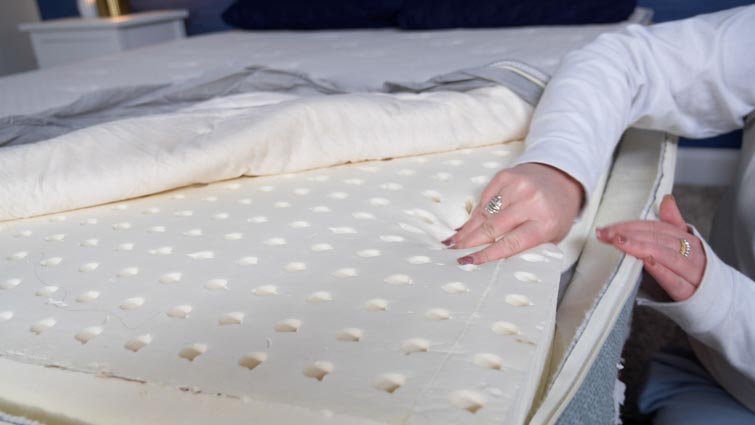
Mattress Materials
Many sleepers who struggle with allergies are often comfortable on a sustainable mattress or one made with eco-friendly and organic materials, as these beds are unlikely to activate their allergies. If this sounds like you, we recommend looking for mattresses that receive third-party certifications for using natural materials and ethical practices. You can check out our guide to mattress certifications to learn more, in addition to perusing our roundup of the best organic mattresses.
Check for Certification
If you’re looking for a hypoallergenic mattress, it’s a good idea to check if it has received third-party certifications, such as the OEKO-TEX certification and GOTS (Global Organic Textile Standard) certification.
OEKO-TEX STANDARD 100 means your bed is free from harmful chemicals and is non-toxic to humans. GOTS applies to the mattress’ cover, and means it’s certified organic. This certification focuses on environmental and social responsibility. Learn more about mattress certifications in our guide here.
Sleeping Position
Here’s a quick rundown of the different sleeping positions and what we recommend.
- Back sleepers: These sleepers need a mattress that’s going to help promote spinal alignment and healthy sleep posture by offering support and pressure relief. They usually do best on hybrid or innerspring mattresses.
- Side sleepers: Side sleepers do well on soft or contouring beds, like memory foam mattresses or many hybrid mattresses.
- Stomach sleepers: Stomach sleepers tend to do best on a firm mattress since it allows their hips to be lifted and in line with their shoulders. This ultimately helps prevent back pain. We think they do well on innerspring and hybrid mattresses.
- Combination sleepers: These are sleepers who switch between two or more sleeping positions at night. They typically want a responsive mattress so they don’t feel stuck in the bed while trying to switch positions. A lot of beds can cater to their needs, like latex mattresses, hybrid mattresses, and innerspring mattresses.
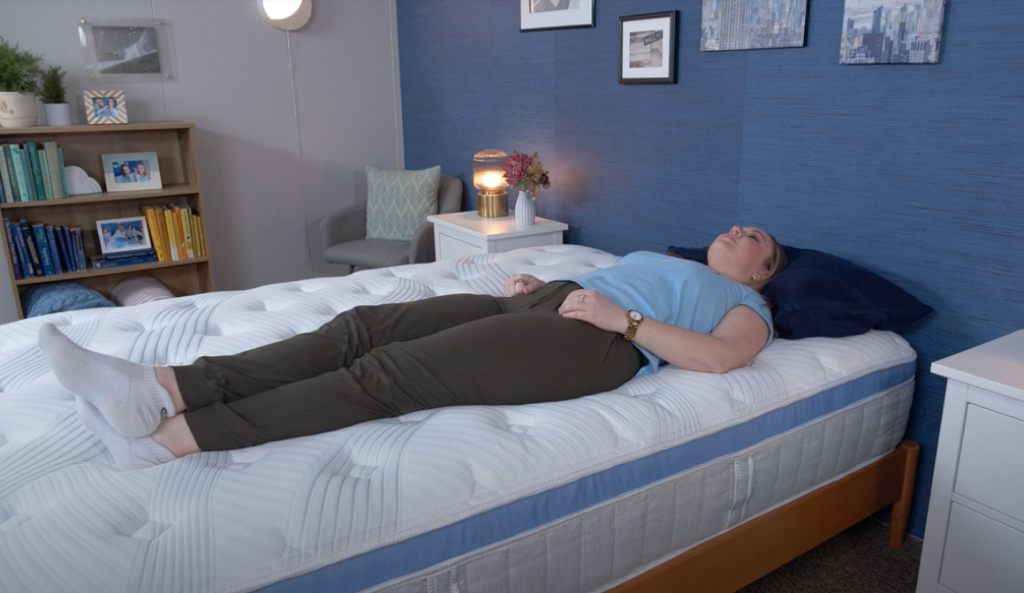
Body Types
We categorize lightweight sleepers as weighing less than 130 pounds, average weight sleepers as weighing between 130 and 250 pounds, and heavy sleepers as weighing more than 250 pounds. Beds are typically going to feel firmer to lightweight sleepers than they do heavyweight sleepers. If you’re heavier in weight, you’re also going to need more support from a bed. We typically recommend heavier sleepers look at the best innerspring mattresses or one that was designed with them in mind. They can also refer to our roundup of the best mattresses for heavy people to see some options tailored for them.
FAQs
What are some other healthy types of mattresses?
Organic/natural mattresses. Along with being hypoallergenic, they’re free of toxins, moisture-wicking, and more naturally breathable than non-organic mattresses.
How do I tell if my mattress contains toxic materials or not?
You’ll want to check if your mattress has received third-party certifications, such as the OEKO-TEX certification and GOTS (Global Organic Textile Standard) certification. OEKO-TEX STANDARD 100 means your bed is free from harmful chemicals. GOTS applies to the mattress’ cover, and means it’s certified organic.
What hypoallergenic bedding do you recommend?
We recommend looking for natural materials, like cotton, wool, silk, and bamboo. You can also purchase a hypoallergenic mattress cover for even more protection.
How can I prevent allergens or dust mites from being on my mattress?
Clean your bed twice a year and wash your sheets/bedding weekly. Check out our full mattress cleaning guide for more information.
How We Chose These Mattresses
Our team of Certified Sleep Science Coaches has reviewed more than 220 products in our mattress lab, running each one through tests such as pressure-mapping and measuring motion transfer with a seismometer. From there, we give every bed an overall score based on materials, comfort, support, cooling, and edge support. We also factor in brand performance with categories such as value and warranty.
For the mattresses on this page, we considered whether they’re made with hypoallergenic and eco-friendly materials, what types of sleepers they would work for, how budget-friendly they are, and more. Click here to learn more about our methodology.
Best Hypoallergenic Mattresses
| Mattress | Best For | Price (Queen) | Coupon | Review |
| Puffy Cloud | Overall | $1,799 | Puffy Coupon | Read Our Review! |
| DreamCloud | Combination Sleepers | $1,798 | DreamCloud Coupon | Read Our Review! |
| Saatva Latex Hybrid | Hybrid | $2,195 | Saatva Coupon | Read Our Review |
| WinkBeds EcoCloud | Back Pain | $1,999 | WinkBeds Coupon | Read Our Review |
| Nectar Premier | Couples | $1,299 | Nectar Coupon | Read Our Review |
| Helix Dawn | Firm | $1,199 | Helix Coupon | Read Our Review |
| Bear Star Hybrid | Cooling | $1,732 | Bear Coupon | Read Our Review |
| Nolah Natural | Side Sleepers | $1,899 | Nolah Coupon | Read Our Review |
| Birch | Organic | $1,811 | Birch Coupon | Read Our Review |
| Layla | Flippable | $1,099 | Layla Coupon | Read Our Review |
